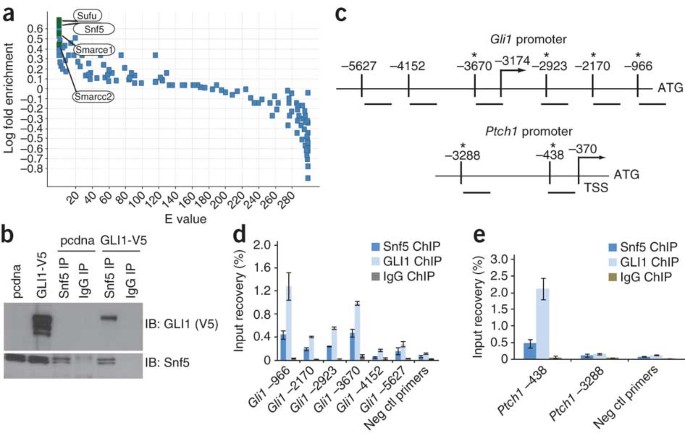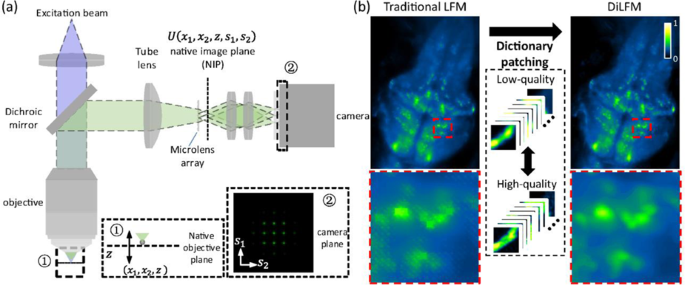
- Select a language for the TTS:
- UK English Female
- UK English Male
- US English Female
- US English Male
- Australian Female
- Australian Male
- Language selected: (auto detect) - EN
Play all audios:
ABSTRACT Aberrant activation of the Hedgehog (Hh) pathway can drive tumorigenesis1. To investigate the mechanism by which glioma-associated oncogene family zinc finger-1 (GLI1), a crucial
effector of Hh signaling2, regulates Hh pathway activation, we searched for GLI1-interacting proteins. We report that the chromatin remodeling protein SNF5 (encoded by _SMARCB1_, hereafter
called _SNF5_), which is inactivated in human malignant rhabdoid tumors (MRTs), interacts with GLI1. We show that Snf5 localizes to Gli1-regulated promoters and that loss of Snf5 leads to
activation of the Hh-Gli pathway. Conversely, re-expression of SNF5 in MRT cells represses GLI1. Consistent with this, we show the presence of a Hh-Gli–activated gene expression profile in
primary MRTs and show that GLI1 drives the growth of _SNF5_-deficient MRT cells _in vitro_ and _in vivo_. Therefore, our studies reveal that SNF5 is a key mediator of Hh signaling and that
aberrant activation of GLI1 is a previously undescribed targetable mechanism contributing to the growth of MRT cells. Access through your institution Buy or subscribe This is a preview of
subscription content, access via your institution ACCESS OPTIONS Access through your institution Subscribe to this journal Receive 12 print issues and online access $209.00 per year only
$17.42 per issue Learn more Buy this article * Purchase on SpringerLink * Instant access to full article PDF Buy now Prices may be subject to local taxes which are calculated during checkout
ADDITIONAL ACCESS OPTIONS: * Log in * Learn about institutional subscriptions * Read our FAQs * Contact customer support SIMILAR CONTENT BEING VIEWED BY OTHERS TRANSCRIPTION FACTOR SNAI2
EXERTS PRO-TUMORIGENIC EFFECTS ON GLIOMA STEM CELLS VIA PHLPP2-MEDIATED AKT PATHWAY Article Open access 02 June 2022 THE HIRA COMPLEX REGULATES GLI3R-DEPENDENT TRANSCRIPTION IN HEDGEHOG
SIGNALING AND MEDULLOBLASTOMA CELL GROWTH AND MIGRATION Article Open access 02 January 2025 SALL4 IS A CRL3REN/KCTD11 SUBSTRATE THAT DRIVES SONIC HEDGEHOG-DEPENDENT MEDULLOBLASTOMA Article
Open access 07 December 2023 REFERENCES * Jiang, J. & Hui, C.C. Hedgehog signaling in development and cancer. _Dev. Cell_ 15, 801–812 (2008). Article CAS Google Scholar * Ruiz i
Altaba, A., Mas, C. & Stecca, B. The Gli code: an information nexus regulating cell fate, stemness and cancer. _Trends Cell Biol._ 17, 438–447 (2007). Article CAS Google Scholar *
Gailani, M.R. et al. The role of the human homologue of _Drosophila_ patched in sporadic basal cell carcinomas. _Nat. Genet._ 14, 78–81 (1996). Article CAS Google Scholar * Raffel, C. et
al. Sporadic medulloblastomas contain PTCH mutations. _Cancer Res._ 57, 842–845 (1997). CAS PubMed Google Scholar * Kinzler, K.W. et al. Identification of an amplified, highly expressed
gene in a human glioma. _Science_ 236, 70–73 (1987). Article CAS Google Scholar * Northcott, P.A. et al. Multiple recurrent genetic events converge on control of histone lysine
methylation in medulloblastoma. _Nat. Genet._ 41, 465–472 (2009). Article CAS Google Scholar * Kogerman, P. et al. Mammalian suppressor-of-fused modulates nuclear-cytoplasmic shuttling of
Gli-1. _Nat. Cell Biol._ 1, 312–319 (1999). Article CAS Google Scholar * Roberts, C.W. & Orkin, S.H. The SWI/SNF complex–chromatin and cancer. _Nat. Rev. Cancer_ 4, 133–142 (2004).
Article CAS Google Scholar * Weissman, B. & Knudsen, K.E. Hijacking the chromatin remodeling machinery: impact of SWI/SNF perturbations in cancer. _Cancer Res._ 69, 8223–8230 (2009).
Article CAS Google Scholar * Wu, J.I., Lessard, J. & Crabtree, G.R. Understanding the words of chromatin regulation. _Cell_ 136, 200–206 (2009). Article CAS Google Scholar *
Goodrich, L.V., Johnson, R.L., Milenkovic, L., McMahon, J.A. & Scott, M.P. Conservation of the hedgehog/patched signaling pathway from flies to mice: induction of a mouse patched gene by
Hedgehog. _Genes Dev._ 10, 301–312 (1996). Article CAS Google Scholar * Lee, J., Platt, K.A., Censullo, P. & Ruiz i Altaba, A. Gli1 is a target of Sonic hedgehog that induces ventral
neural tube development. _Development_ 124, 2537–2552 (1997). CAS PubMed Google Scholar * Isakoff, M.S. et al. Inactivation of the Snf5 tumor suppressor stimulates cell cycle progression
and cooperates with p53 loss in oncogenic transformation. _Proc. Natl. Acad. Sci. USA_ 102, 17745–17750 (2005). Article CAS Google Scholar * Logan, M. et al. Expression of Cre
recombinase in the developing mouse limb bud driven by a Prxl enhancer. _Genesis_ 33, 77–80 (2002). Article CAS Google Scholar * Martin, J.F. & Olson, E.N. Identification of a prx1
limb enhancer. _Genesis_ 26, 225–229 (2000). Article CAS Google Scholar * Theil, T., Kaesler, S., Grotewold, L., Bose, J. & Ruther, U. Gli genes and limb development. _Cell Tissue
Res._ 296, 75–83 (1999). Article CAS Google Scholar * Wang, X. et al. Oncogenesis caused by loss of the SNF5 tumor suppressor is dependent on activity of BRG1, the ATPase of the SWI/SNF
chromatin remodeling complex. _Cancer Res._ 69, 8094–8101 (2009). Article CAS Google Scholar * Biegel, J.A. et al. Germ-line and acquired mutations of INI1 in atypical teratoid and
rhabdoid tumors. _Cancer Res._ 59, 74–79 (1999). CAS PubMed Google Scholar * Sévenet, N. et al. Constitutional mutations of the hSNF5/INI1 gene predispose to a variety of cancers. _Am. J.
Hum. Genet._ 65, 1342–1348 (1999). Article Google Scholar * Versteege, I. et al. Truncating mutations of hSNF5/INI1 in aggressive paediatric cancer. _Nature_ 394, 203–206 (1998). Article
CAS Google Scholar * McKenna, E.S. et al. Loss of the epigenetic tumor suppressor SNF5 leads to cancer without genomic instability. _Mol. Cell. Biol._ 28, 6223–6233 (2008). Article CAS
Google Scholar * McKenna, E.S. & Roberts, C.W. Epigenetics and cancer without genomic instability. _Cell Cycle_ 8, 23–26 (2009). Article CAS Google Scholar * Pomeroy, S.L. et al.
Prediction of central nervous system embryonal tumour outcome based on gene expression. _Nature_ 415, 436–442 (2002). Article CAS Google Scholar * Wisniewski, D. et al. Characterization
of potent inhibitors of the Bcr-Abl and the c-kit receptor tyrosine kinases. _Cancer Res._ 62, 4244–4255 (2002). CAS PubMed Google Scholar * Hyman, J.M. et al. Small-molecule inhibitors
reveal multiple strategies for Hedgehog pathway blockade. _Proc. Natl. Acad. Sci. USA_ 106, 14132–14137 (2009). Article CAS Google Scholar * Pan, S. et al. Discovery of NVP-LDE225, a
potent and selective smoothened antagonist. _ACS Med. Chem. Lett._ 1, 130–134 (2010). Article CAS Google Scholar * Chai, J., Charboneau, A.L., Betz, B.L. & Weissman, B.E. Loss of the
hSNF5 gene concomitantly inactivates p21CIP/WAF1 and p16INK4a activity associated with replicative senescence in A204 rhabdoid tumor cells. _Cancer Res._ 65, 10192–10198 (2005). Article CAS
Google Scholar * Lee, D. et al. SWI/SNF complex interacts with tumor suppressor p53 and is necessary for the activation of p53-mediated transcription. _J. Biol. Chem._ 277, 22330–22337
(2002). Article CAS Google Scholar * Nagl, N.G. Jr., Zweitzig, D.R., Thimmapaya, B., Beck, G.R. Jr. & Moran, E. The c-myc gene is a direct target of mammalian SWI/SNF-related
complexes during differentiation-associated cell cycle arrest. _Cancer Res._ 66, 1289–1293 (2006). Article CAS Google Scholar * Tsikitis, M., Zhang, Z., Edelman, W., Zagzag, D. &
Kalpana, G.V. Genetic ablation of cyclin D1 abrogates genesis of rhabdoid tumors resulting from Ini1 loss. _Proc. Natl. Acad. Sci. USA_ 102, 12129–12134 (2005). Article CAS Google Scholar
* Rudin, C.M. et al. Treatment of medulloblastoma with hedgehog pathway inhibitor GDC-0449. _N. Engl. J. Med._ 361, 1173–1178 (2009). Article CAS Google Scholar * Bouwmeester, T. et al.
A physical and functional map of the human TNF-α/NF-κB signal transduction pathway. _Nat. Cell Biol._ 6, 97–105 (2004). Article CAS Google Scholar * Frank-Kamenetsky, M. et al.
Small-molecule modulators of Hedgehog signaling: identification and characterization of Smoothened agonists and antagonists. _J. Biol._ 1, 10 (2002). Article Google Scholar * Turner, F.B.,
Cheung, W.L. & Cheung, P. Chromatin immunoprecipitation assay for mammalian tissues. _Methods Mol. Biol._ 325, 261–272 (2006). CAS PubMed Google Scholar * Roberts, C.W., Leroux,
M.M., Fleming, M.D. & Orkin, S.H. Highly penetrant, rapid tumorigenesis through conditional inversion of the tumor suppressor gene Snf5. _Cancer Cell_ 2, 415–425 (2002). Article CAS
Google Scholar * Riddle, R.D., Johnson, R.L., Laufer, E. & Tabin, C. Sonic hedgehog mediates the polarizing activity of the ZPA. _Cell_ 75, 1401–1416 (1993). Article CAS Google
Scholar * Irizarry, R.A. et al. Exploration, normalization, and summaries of high density oligonucleotide array probe level data. _Biostatistics_ 4, 249–264 (2003). Article Google Scholar
* Barbie, D.A. et al. Systematic RNA interference reveals that oncogenic KRAS-driven cancers require TBK1. _Nature_ 462, 108–112 (2009). Article CAS Google Scholar * Subramanian, A. et
al. Gene set enrichment analysis: a knowledge-based approach for interpreting genome-wide expression profiles. _Proc. Natl. Acad. Sci. USA_ 102, 15545–15550 (2005). Article CAS Google
Scholar Download references ACKNOWLEDGEMENTS We thank X. Wang, A. Bouret, J. DaSilva and A. Carlson for their assistance and S. S. Kadam for critical advice. The _Gli1_ probe was generously
provided by C. Tabin (Harvard University Medical School). AUTHOR INFORMATION Author notes * Marion Dorsch Present address: Present address: Sanofi-Aventis, Cambridge, Massachusetts, USA., *
Charles W M Roberts and Marion Dorsch: These authors contributed equally to this work. AUTHORS AND AFFILIATIONS * Novartis Institutes for BioMedical Research, Cambridge, Massachusetts, USA
Zainab Jagani, Dongshu Chen, Justin Klekota, Kathy Hsiao, Silvia Buonamici, Sarah J Luchansky, Joshua Murtie, Joseph F Kelleher, Markus Warmuth, William R Sellers & Marion Dorsch *
Department of Pediatric Oncology, Division of Hematology/Oncology, Dana-Farber Cancer Institute, Children's Hospital Boston, Boston, Massachusetts, USA E Lorena Mora-Blanco, Courtney G
Sansam, Elizabeth S McKenna, Boris Wilson, Phuong T L Nguyen & Charles W M Roberts * Broad Institute of Harvard and M.I.T, Cambridge, Massachusetts, USA Pablo Tamayo, Yoon-Jae Cho &
Jill P Mesirov * Center for Biomedical Informatics, Harvard Medical School, Boston, Massachusetts, USA Michael Tolstorukov & Peter J Park * Department of Neurology, Children's
Hospital Boston, Boston, Massachusetts, USA Yoon-Jae Cho & Scott L Pomeroy * Novartis Institutes for BioMedical Research, Basel, Switzerland Heinz Ruffner & Tewis Bouwmeester Authors
* Zainab Jagani View author publications You can also search for this author inPubMed Google Scholar * E Lorena Mora-Blanco View author publications You can also search for this author
inPubMed Google Scholar * Courtney G Sansam View author publications You can also search for this author inPubMed Google Scholar * Elizabeth S McKenna View author publications You can also
search for this author inPubMed Google Scholar * Boris Wilson View author publications You can also search for this author inPubMed Google Scholar * Dongshu Chen View author publications You
can also search for this author inPubMed Google Scholar * Justin Klekota View author publications You can also search for this author inPubMed Google Scholar * Pablo Tamayo View author
publications You can also search for this author inPubMed Google Scholar * Phuong T L Nguyen View author publications You can also search for this author inPubMed Google Scholar * Michael
Tolstorukov View author publications You can also search for this author inPubMed Google Scholar * Peter J Park View author publications You can also search for this author inPubMed Google
Scholar * Yoon-Jae Cho View author publications You can also search for this author inPubMed Google Scholar * Kathy Hsiao View author publications You can also search for this author
inPubMed Google Scholar * Silvia Buonamici View author publications You can also search for this author inPubMed Google Scholar * Scott L Pomeroy View author publications You can also search
for this author inPubMed Google Scholar * Jill P Mesirov View author publications You can also search for this author inPubMed Google Scholar * Heinz Ruffner View author publications You
can also search for this author inPubMed Google Scholar * Tewis Bouwmeester View author publications You can also search for this author inPubMed Google Scholar * Sarah J Luchansky View
author publications You can also search for this author inPubMed Google Scholar * Joshua Murtie View author publications You can also search for this author inPubMed Google Scholar * Joseph
F Kelleher View author publications You can also search for this author inPubMed Google Scholar * Markus Warmuth View author publications You can also search for this author inPubMed Google
Scholar * William R Sellers View author publications You can also search for this author inPubMed Google Scholar * Charles W M Roberts View author publications You can also search for this
author inPubMed Google Scholar * Marion Dorsch View author publications You can also search for this author inPubMed Google Scholar CONTRIBUTIONS Z.J. initiated the studies, conducted most
of the experiments, analyzed data and wrote the manuscript. E.L.M.-B. conducted the _Gli1 in situ_ experiments. C.G.S. generated Snf5-inactivated MEFs. E.S.M. contributed to Snf5
re-expression studies. B.W. assisted with ChIP studies. D.C. and J.M. conducted _in vivo_ experiments. J.K. performed statistical analysis from interaction screen. P.T., Y.-J.C., J.P.M. and
S.L.P. contributed to the gene expression analysis. M.T. and P.J.P. performed nucleosome repositioning assays. H.R., T.B., S.J.L. and J.F.K. contributed to the TAP-protein interaction
screen. P.T.L.N. contributed to GLI shRNA studies. K.H. generated vectors for GLI1 deletions. S.B. contributed to the writing of the manuscript. M.W., W.R.S., C.W.M.R. and M.D. supervised
the studies, assisted in data analysis and contributed to the writing of the manuscript. CORRESPONDING AUTHORS Correspondence to Charles W M Roberts or Marion Dorsch. ETHICS DECLARATIONS
COMPETING INTERESTS Z.J., D.C., J.P.M., K.H., S.B., J.K., H.R., T.B., S.L., J.F.K., M.W., and W.R.S. are employees of the Novartis Institutes for BioMedical Research (NIBR). SUPPLEMENTARY
INFORMATION SUPPLEMENTARY TEXT AND FIGURES Supplementary Figures 1–11 and Supplementary Methods (PDF 1013 kb) RIGHTS AND PERMISSIONS Reprints and permissions ABOUT THIS ARTICLE CITE THIS
ARTICLE Jagani, Z., Mora-Blanco, E., Sansam, C. _et al._ Loss of the tumor suppressor Snf5 leads to aberrant activation of the Hedgehog-Gli pathway. _Nat Med_ 16, 1429–1433 (2010).
https://doi.org/10.1038/nm.2251 Download citation * Received: 25 March 2010 * Accepted: 30 September 2010 * Published: 14 November 2010 * Issue Date: December 2010 * DOI:
https://doi.org/10.1038/nm.2251 SHARE THIS ARTICLE Anyone you share the following link with will be able to read this content: Get shareable link Sorry, a shareable link is not currently
available for this article. Copy to clipboard Provided by the Springer Nature SharedIt content-sharing initiative







